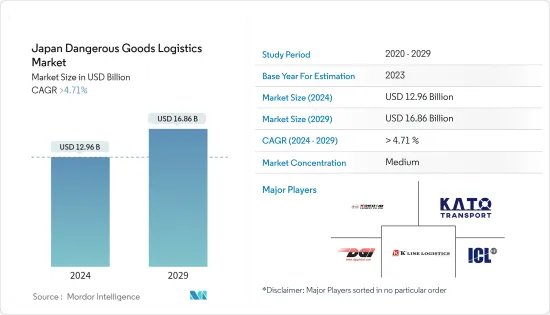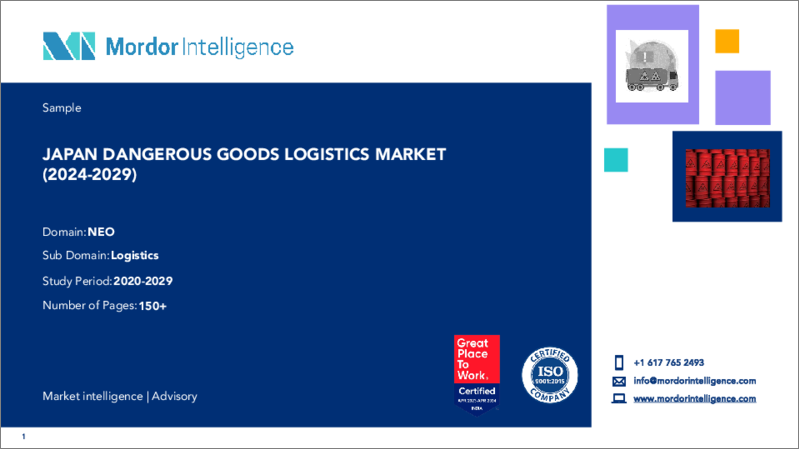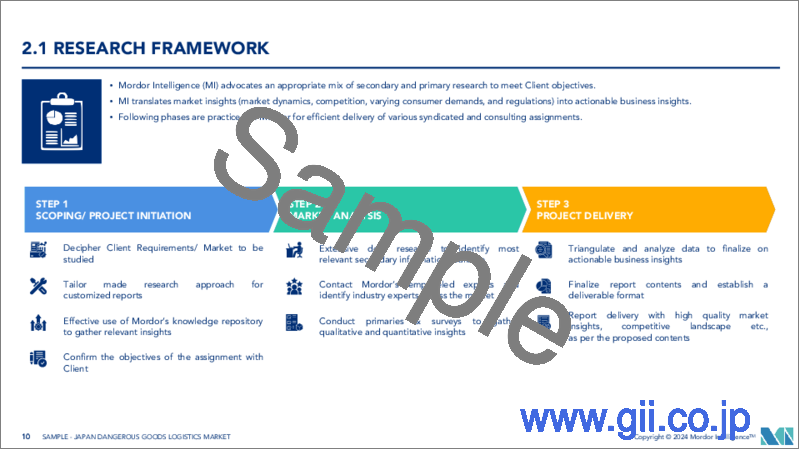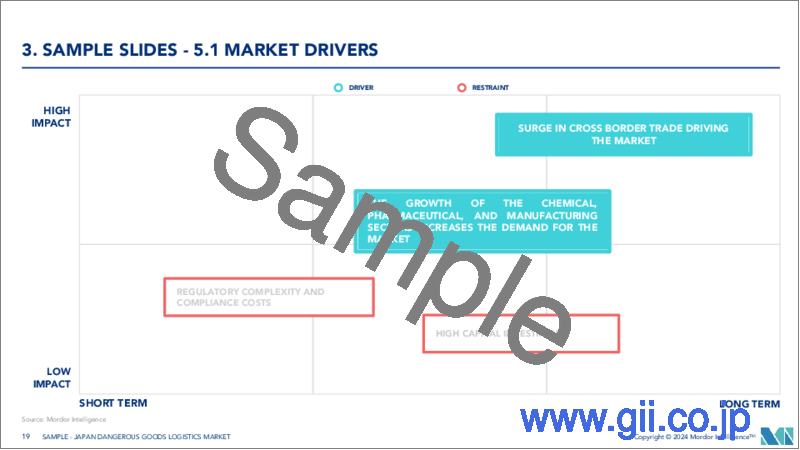|
|
市場調査レポート
商品コード
1521695
日本の危険物ロジスティクス-市場シェア分析、産業動向・統計、成長予測(2024年~2029年)Japan Dangerous Goods Logistics - Market Share Analysis, Industry Trends & Statistics, Growth Forecasts (2024 - 2029) |
||||||
カスタマイズ可能
適宜更新あり
|
|||||||
| 日本の危険物ロジスティクス-市場シェア分析、産業動向・統計、成長予測(2024年~2029年) |
|
出版日: 2024年07月15日
発行: Mordor Intelligence
ページ情報: 英文 150 Pages
納期: 2~3営業日
|
全表示
- 概要
- 目次
日本の危険物ロジスティクス市場規模は2024年に129億6,000万米ドルと推定され、2029年には168億6,000万米ドルに達すると予測され、予測期間中(2024~2029年)のCAGRは4.71%以上で成長すると予測されます。

市場成長の原動力となっているのは、さまざまな産業における危険物需要の増加、輸送や取り扱いに関する規制の強化、eコマースの台頭といった要因です。日本で輸送される危険物の主要タイプには、化学薬品、爆発物、引火性液体、放射性物質などがあります。
企業は、規制や人材不足といった課題に対処するため、技術やパートナーシップに投資しています。例えば、三菱重工業は、繊細な危険物の温度と圧力をリアルタイムで監視できるスマートコンテナソリューションを発表しました。
国土交通省は2024年1月、建設や解体で使用される火薬類に対する規制を強化するため、「火薬類取締法」の改正を発表しました。これは、これらの資材を輸送する物流会社に影響を与える可能性があります。
2023年11月、大手物流会社のYamato Transportが郵船ロジスティクスと提携し、危険物市場で成長セグメントであるリチウムイオン電池に特化した輸送サービスを開始しました。また、2023年10月には、もう一つの大手企業である日本通運が、大阪に危険物の取り扱いに特化した新しい物流施設を開設し、業界を紹介することを発表しました。
日本の危険物物流市場の動向
eコマースの拡大が危険物需要に貢献
- eコマースプラットフォームは、従来の実店舗に比べ、はるかに多種多様な商品を提供しています。これには、電子機器、化粧品、クリーニング製品、医療実験用品など、危険物に分類されるさまざまな品目が含まれます。消費者は迅速で便利な配送を期待しているため、物流会社は危険物輸送のためにネットワークを最適化する必要に迫られています。これには専用トラック、梱包ソリューション、訓練を受けた人材が必要となります。
- 日本のeコマース市場は2013年以来倍増しており、今後も成長が見込まれます。2022年の企業対消費者(B2C)eコマース市場規模は22兆7,000億円で、前年比9.9%増となります。eコマース市場を牽引しているのは、日本の高いインターネット普及率とネットワークインフラです。モバイルベースのアプリ「Mercari」や、Rakuten、Yahoo Shopping、Amazonといった大手B2C企業のeコマースプラットフォームが、日本のeコマース市場の主要企業です。2023年の調査によると、日本の消費者のほぼ59%の購買行動に影響を与える主要因は低価格です。
- 日本のeコマースサイトは膨大な種類の商品を提供しています。重要なことは、厳格な規制と安全上の懸念から、ほとんどの危険物はオンラインでは容易に購入できないことを明確にしておくことです。しかし、eコマースが特定の危険物の販売を促進する役割を果たす特定のカテゴリーもあります。例えば、特定の染毛剤、マニキュア、さらに一部のスキンケア製品には、引火性や潜在的な健康リスクのために危険物として規制されている成分が含まれている可能性があります。
- Volzaの日本輸出データによると、日本からのクリーニング製品の出荷量は1万970万個で、日本の輸出業者1,706社がバイヤー1,995社に輸出しました。日本はベトナム、インド、トルコにクリーニング製品の大半を輸出しています。クリーニング製品の輸出国トップ3は米国で9万2,558個、次いでベトナムで5万9,477個、3位は中国で4万2,909個です。
倉庫保管インフラへの需要増加が市場を牽引
- 医薬品や化学品のような特定の危険物は、安全な保管のために特定の温度範囲を必要とします。そのため、高度な温度管理システムを備えた専用施設が必要となります。可燃性または爆発性の物質には、耐火構造、換気システム、高度な消火技術を備えた特別設計の倉庫が必要です。
- 貴重な金属や危険物のような一部の危険物には、強化されたセキュリティ対策が必要であり、アクセス制限、監視システム、強固なセキュリティ・プロトコルを備えた倉庫が必要となります。
- 2023年7月、Amazon Japanは日本に2つの物流拠点を新設すると発表しました。1つは千葉市、もう1つは埼玉県狭山市で、いずれも首都圏にあります。千葉市に新設されるアマゾン千葉みなとフルフィルメントセンターは、同社にとって日本最大のロボット化された拠点となり、ロボットがラックをピックアップして移動します。自動化されたシステムは作業員を助け、棚に商品を並べたり、棚から商品を取り出したりする時間を短縮します。また、スペースにも余裕ができ、従来の倉庫よりも最大40%多くの在庫をストックできるらしいです。
- NEC Corporationは、日本全国の倉庫に配備されている自律移動ロボット(AMR)の効率を2倍にすることを目指し、施設内を移動する際に速度を自動的に調整することを可能にする新しい「リスク敏感確率制御技術」を開発しました。この技術を2024年3月までに実用化し、全国のNECの協力AMRに導入する計画です。近年、人手不足を背景に、国内の大型倉庫では施設内の資材運搬にロボットが活用されています。これらのAMRは安全性を確保するために走行速度を落として構成されており、輸送効率が課題となっています。
日本の危険物ロジスティクス業界概要
日本の危険物ロジスティクス市場はその性質上セグメント化されており、世界の参入企業と地域参入企業が混在しています。eコマース、技術統合、経済成長などいくつかの要因から、予測期間中、市場は成長すると予想されます。日本の大手企業は、倉庫管理システム、ドローン配送、自動化など、さまざまな最新技術を取り入れています。また、輸送管理システムを採用し、より優れた計画と追跡設備を可能にし、生産性と価値提案の向上をもたらしています。この市場の主要企業は、Kokusai Express、SAGAWA Global Logistics、Nippon Express、K Line Logistics、Yusen Logisticsなどがあります。
その他の特典
- エクセル形式の市場予測(ME)シート
- 3ヶ月間のアナリストサポート
目次
第1章 イントロダクション
- 調査の前提条件
- 調査範囲
第2章 調査手法
第3章 エグゼクティブ概要
第4章 市場洞察
- 現在の市場シナリオ
- 産業バリューチェーン分析
- 政府の規制と取り組み
- 危険物クラス概要
- 技術スナップショット
- COVID-19が市場に与える影響
第5章 市場力学
- 市場促進要因
- 危険物に対する需要の高まり
- eコマースの成長拡大
- 市場抑制要因
- 有資格者の不足
- インフラの限界
- 市場機会
- 技術の進歩
- 業界におけるパートナーシップとコラボレーション
- 業界の魅力-ポーターのファイブフォース分析
- 供給企業の交渉力
- 買い手/消費者の交渉力
- 新規参入業者の脅威
- 代替品の脅威
- 競争企業間の敵対関係の強さ
第6章 市場セグメンテーション
- サービス別
- 輸送
- 倉庫・流通
- 付加価値サービス
- 仕向地別
- 国内
- 国際
第7章 競合情勢
- 市場集中度概要
- 企業プロファイル
- Kokusai Express
- "K" Ling Logistics Limited
- KATO Transport
- DGI(Dangerous Goods International)Global
- ICL Logistics Japan Co Limited
- Nippon Express
- Yamato Transport
- Chikko Corporation
- LOGISTEED Japan Ltd
- Yusen Logistics
- Mitsui Chemicals
- SAGAWA Global Logistics
- Uyeno Logichem Ltd*
- その他の企業
第8章 市場の将来展望
第9章 付録
The Japan Dangerous Goods Logistics Market size is estimated at USD 12.96 billion in 2024, and is expected to reach USD 16.86 billion by 2029, growing at a CAGR of greater than 4.71% during the forecast period (2024-2029).

The market growth is driven by factors such as increasing demand for dangerous goods in various industries, stricter regulations for transportation and handling, and the rise of e-commerce. The major types of dangerous goods transported in Japan include chemicals, explosives, flammable liquids, and radioactive materials.
Companies are investing in technology and partnerships to address challenges like regulations and talent shortages. For instance, Mitsubishi Heavy Industries launched a smart container solution that allows the real-time monitoring of temperature and pressure for sensitive, dangerous goods.
In January 2024, the Ministry of Land, Infrastructure, Transport and Tourism (MLIT) announced revisions to the "Law on the Control of Explosives" to strengthen regulations for explosives used in construction and demolition. This could impact logistics companies transporting these materials.
In November 2023, Yamato Transport, a major logistics company, partnered with Yusen Logistics to offer specialized transportation services for lithium-ion batteries, a growing segment in the dangerous goods market. Also, in October 2023, Nippon Express, another major player, announced opening a new logistics facility in Osaka dedicated to handling dangerous goods and showcasing the industry.
Japan Dangerous Goods Logistics Market Trends
Increasing E-commerce Growth is Contributing to the Demand for Dangerous Goods
- E-commerce platforms offer a much wider variety of products compared to traditional brick-and-mortar stores. This includes a range of items classified as dangerous goods, such as electronics, cosmetics, cleaning products, and medical and laboratory supplies. Consumers expect fast and convenient delivery, which puts pressure on logistics companies to optimize their networks for the transportation of dangerous goods. This can involve dedicated trucks, packaging solutions, and trained personnel.
- Japan's e-commerce market has doubled since 2013 and is expected to continue growing. In 2022, the business-to-consumer (B2C) e-commerce market was valued at JPY 22.7 trillion, which is a 9.9% increase from the previous year. The e-commerce market is driven by Japan's high internet penetration and network infrastructure. The mobile-based app Mercari and re-commerce platforms from major B2C companies like Rakuten, Yahoo Shopping, and Amazon Marketplaces are key players in Japan's e-commerce market. A 2023 survey found that low price is the leading factor influencing the purchase behavior of almost 59% of Japanese consumers.
- The e-commerce sites in Japan offer a vast array of products. It is important to clarify that most dangerous goods are not readily available for purchase online due to strict regulations and safety concerns. However, there are some specific categories where e-commerce does play a role in facilitating the sale of certain dangerous goods. For instance, certain hair dyes, nail polishes, and even some skincare products might contain ingredients regulated as dangerous goods due to flammability or potential health risks.
- As per Volza's Japan Export data, cleaning product shipments from Japan stood at 19.7K, exported by 1,706 Japanese exporters to 1,995 buyers. Japan exports most of its cleaning products to Vietnam, India, and Turkey. The top three exporters of cleaning products are the United States with 92,558 shipments, followed by Vietnam with 59,477, and China at the third spot with 42,909 shipments.
Increasing Demand for Warehouse Storage Infrastructures is Driving the Market
- Certain dangerous goods, like pharmaceuticals or chemicals, require specific temperature ranges for safe storage. This necessitates dedicated facilities with advanced temperature control systems. Flammable or explosive materials require specially designed warehouses with fire-resistant construction, ventilation systems, and advanced fire suppression technologies.
- Some dangerous goods, like valuable metals or hazardous materials, require enhanced security measures, necessitating warehouses with restricted access, surveillance systems, and robust security protocols.
- In July 2023, Amazon Japan announced that it would establish two new distribution hubs in Japan, one in the city of Chiba and the other in the Saitama Prefecture City of Sayama, both in the greater Tokyo area. Amazon Chiba Minato Fulfillment Center, to be created in the city of Chiba, will be the company's largest robotized hub in Japan, where robots pick up racks and move around. The automated system will help workers and reduce the time spent stocking the shelves and taking items off the racks. It also allows for more space, and the building can apparently stock up to 40% more inventory than conventional warehouses.
- NEC Corporation aims to double the efficiency of autonomous mobile robots (AMRs) deployed in warehouses across Japan by developing a new "risk-sensitive stochastic control technology" that enables them to automatically adjust their speed as they navigate the facility. The company planned to put this technology into practice by March 2024 and have it installed in NEC's cooperative AMRs in the nation. In recent years, the labor shortage has pushed large warehouses in Japan to use robots to transport materials within their facilities. These AMRs are configured to travel with reduced speed to ensure safety, making transport efficiency a challenge.
Japan Dangerous Goods Logistics Industry Overview
The Japanese dangerous goods logistics market is fragmented in nature, with a mix of global and regional players. The market is expected to grow during the forecast period due to several factors, such as e-commerce, technology integration, and growing economies. The major companies in Japan have embraced various modern technologies, such as warehousing management systems, drone delivery, and automation. They have also adopted the transportation management system, which enabled better planning and tracking facilities, resulting in increased productivity and value proposition. The major players in this market are Kokusai Express, SAGAWA Global Logistics, Nippon Express, K Line Logistics, and Yusen Logistics.
Additional Benefits:
- The market estimate (ME) sheet in Excel format
- 3 months of analyst support
TABLE OF CONTENTS
1 INTRODUCTION
- 1.1 Study Assumptions
- 1.2 Scope of the Study
2 RESEARCH METHODOLOGY
3 EXECUTIVE SUMMARY
4 MARKET INSIGHTS
- 4.1 Current Market Scenario
- 4.2 Industry Value Chain Analysis
- 4.3 Government Regulations and Initiatives
- 4.4 Brief on Dangerous Goods Classes
- 4.5 Technology Snapshot
- 4.6 Impact of COVID-19 on the Market
5 MARKET DYNAMICS
- 5.1 Market Drivers
- 5.1.1 Growing Demand for Dangerous Goods
- 5.1.2 Increasing E-commerce Growth
- 5.2 Market Restraints
- 5.2.1 Lack of Qualified Personnel
- 5.2.2 Infrastructure Limitations
- 5.3 Market Opportunities
- 5.3.1 Technological Advancements
- 5.3.2 Partnerships and Collaborations in the Industry
- 5.4 Industry Attractiveness - Porter's Five Forces Analysis
- 5.4.1 Bargaining Power of Suppliers
- 5.4.2 Bargaining Power of Buyers/Consumers
- 5.4.3 Threat of New Entrants
- 5.4.4 Threat of Substitutes
- 5.4.5 intensity of Competitive Rivalry
6 MARKET SEGMENTATION
- 6.1 By Service
- 6.1.1 Transportation
- 6.1.2 Warehousing and Distribution
- 6.1.3 Value-added Services
- 6.2 By Destination
- 6.2.1 Domestic
- 6.2.2 International
7 COMPETITIVE LANDSCAPE
- 7.1 Market Concentration Overview
- 7.2 Company Profiles
- 7.2.1 Kokusai Express
- 7.2.2 "K" Ling Logistics Limited
- 7.2.3 KATO Transport
- 7.2.4 DGI (Dangerous Goods International) Global
- 7.2.5 ICL Logistics Japan Co Limited
- 7.2.6 Nippon Express
- 7.2.7 Yamato Transport
- 7.2.8 Chikko Corporation
- 7.2.9 LOGISTEED Japan Ltd
- 7.2.10 Yusen Logistics
- 7.2.11 Mitsui Chemicals
- 7.2.12 SAGAWA Global Logistics
- 7.2.13 Uyeno Logichem Ltd*
- 7.3 Other Companies






